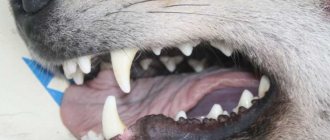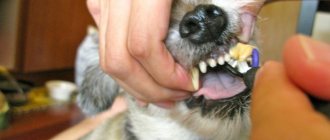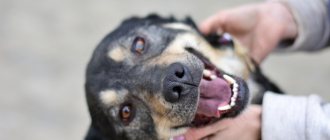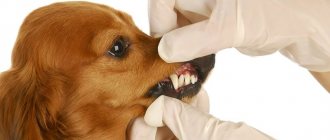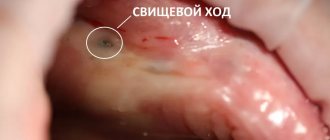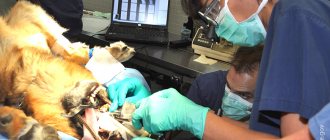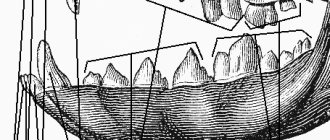A healthy
bite requires the presence of 20 teeth in the upper jaw and 22 in the lower jaw.
The full “combat kit” grows only by 1 year. Until this moment, puppies’ teeth go through two important stages: the first eruption and the change to molars. Both events have their pitfalls, so the owner must carefully monitor the well-being of his four-legged pet and not forget about the importance of oral care.
Changing teeth in puppies
A newborn puppy is born unable to independently regulate its body temperature, blind, deaf and without teeth.
The first milk teeth grow by 20–30 days of life. A complete set - 32 milk teeth - appears only by two to three months.
First, 4 fangs grow. Then 12 incisors - 6 each on the upper and lower jaws, and the last - 16 premolars. Puppies do not have molars, or molars.
At the age of 3–7 months, the puppy begins the period of changing teeth. Dairy ones are replaced with regular ones. The process goes in this order: first, at the age of about 3 months, the primary incisors fall out. Then, at 4–5 months, premolars appear, and by 6–7 months, the canines change and molars—molars—grow. By 8–9 months, the puppy should have a full set of 42 permanent teeth.
During the period of teeth change, daily inspection of the puppy’s mouth is very important.
The change of teeth is due to the fact that the rather long root of the baby tooth gradually dissolves, weakens and is pushed out by the growing permanent tooth. During the period of teeth change, daily inspection of the puppy’s mouth is very important.
Sometimes, this is especially common in small and short-faced breeds of dogs, a permanent tooth grows next to the milk tooth. This is due to the weak development of the chewing muscles, a decrease in the size of the gums, and the puppy feeding on soft food.
If a baby tooth is loose, the owner can carefully loosen and pull it out by grasping it with a gauze napkin. But in cases where the permanent teeth have already grown in, but the baby teeth have not fallen out, when the replacement of teeth is very delayed or any other deviations from the norm are noticeable, it would be best to show the puppy to a veterinary dentist.
Any irregularity in the change of teeth can affect the formation of the dog's jaws and bite. It is better to remove all milk teeth that have not fallen out in time.
Firstly, this frees up space for permanent teeth, and secondly, the formation of a correct bite occurs.
Massaging the gums is also helpful, as it relieves discomfort in the puppy's mouth. It is also necessary to properly feed the puppy, which helps the teeth change faster.
When a puppy's teeth change, he gnaws and chews things, furniture, shoes. This is how he tries to get rid of unpleasant sensations
The teething process takes several months and can be quite sensitive for the puppy. During this period, his immunity weakens, so it is better to refrain from vaccinations. The puppy should not be overcooled or overdo it with walks and training.
When a puppy's teeth change, he gnaws and chews things, furniture, shoes. This is how he tries to get rid of unpleasant sensations. Sometimes general malaise, poor appetite, lethargy, gastrointestinal upset, and fever are noticeable.
To reduce the risk of puppy disease, all vaccinations should be completed before teething begins. Provide your puppy with a variety of toys to help massage his gums. Spend more time with the puppy, distracting him from damaging things. If you don't do this, your dog's habit of gnawing and chewing your furniture and things will remain for life, and it will be very difficult to get rid of it.
In large dogs, the process of changing teeth goes faster. But a previous illness, surgery, injury, docking of the tail or ears can slow down this process.
What to feed the animal during this period
When puppies change their teeth, they experience discomfort, sometimes quite severe. The pet may refuse to eat altogether. This means that the food needs to be changed. To keep your pet healthy, it should be switched to something between semi-liquid and liquid food. Sometimes the puppy can only lap or lick. In this case, he needs to be given broths and fermented milk, meat and vegetable puree.
Important! You can use special dog food. But only very high quality and in the form of pate.
Teething order
The first teeth to appear are the baby teeth. This occurs on the 20-30th day from birth. Dogs are predators and first of all they grow 6 incisors on each jaw, 12 in total. Canines - 2 canines on each jaw. The last to erupt are the 16 premolars. The total number of baby teeth is 32 in a puppy aged 2-3 months (in some breeds – 28).
Large breeds
In large dog breeds, this process is fairly quick and painless. The huge mouth provides space for proper eruption and further development of the dental arch. Problems occur when the animal is exhausted, has suffered a deep maxillofacial injury, breeding control and breed line are not maintained, or close mixing of blood has occurred.
The process is similar to large breeds, but the closer to the lower limit of medium-sized dogs, the greater the likelihood of pathologies (delayed shifts, missing teeth, etc.).
Small breeds
This group of dogs is most susceptible to dental risks. The process itself is very slow and delayed compared to other large dogs. Breeds with flattened faces often suffer from missing teeth. Access to the oral cavity is limited and control is difficult.
You might be interested
How to properly trim a dog's nails - tools and safety precautions
Trimming and filing nails is one of the hygiene procedures necessary for a dog. As a rule, growing…read more
Instructions on how to wash your dog correctly - how often and what to wash with
Let us immediately note that for most dogs, bathing is not a natural process at all. In nature, ...read more
Yorkshire Terrier - training, care and nutrition
Yorkshire Terriers are great pets. They don't require very long walks, they ...read more
Labrador puppy - care and education at home
When an incredibly funny and cute Labrador puppy appears in a family, not everyone is fully …read more
Proper care of a German Shepherd puppy at all stages of its development
The German Shepherd is a multifunctional dog breed that has excellent qualities. To grow a healthy and beautiful…read more
Your puppy is teething – how do you know what the symptoms are?
In most cases, the process of teething in a puppy is invisible and painless. The increase in temperature can be short-term and pass during sleep or rest. The owner himself must control the process. To do this, just run your finger along your pet's gums.
Important! The animal’s gums itch in any case, and the dog begins to chew everything it sees to get rid of this sensation.
For this, the owner should stock up on large beef bones (mosles) or special products from the pet store - toys, bones, etc.
Chew toys
The puppy should have his own toys, which he can chew to his heart's content. Made from thick rubber, dog toys can easily withstand the pressure of growing teeth. Puppies especially like squeaky toys. True, they tear faster and the load on the owner’s ears increases.
You should not give your puppy old shoes to chew on: the baby may not notice the difference between an old slipper and new shoes. Shoes should be an absolute taboo. The same applies to books.
What are the complications of the process?
Formation of malocclusion
The cause can be either genetic or acquired.
- Deformity is inherited.
- Microelement starvation of the mother affects the offspring.
- Exhaustion of the puppy itself.
- Deep injuries.
What does it look like?
When overbiting, the lower jaw bulges forward and the lower incisors become exposed. The rest of the teeth don't match.
Underbite is characterized by protrusion of the upper jaw. Misalignment of remaining teeth.
A straight bite is more difficult to notice because the mouth closes normally.
What to do?
First of all, we turn to a specialist to determine the cause of the pathology. If a shift of the jaws or individual teeth occurs due to retention of a primary incisor, premolar or canine, it can be removed. If the defect goes to the bones, then veterinary dentists use a set of rubber corrector rings. Braces are placed on adult dogs.
Important! For the development and formation of a bite in an animal as a whole, it is necessary to provide a complete diet and proper care.
Well-formed milk teeth in dogs provide a good basis for permanent ones. Even genetic defects can be defeated or smoothed out if the puppy eats well, moves actively, spends a lot of time in the fresh air, and receives all the necessary trace elements and minerals.
Gum inflammation
The process is accompanied by severe itching. The puppy begins to chew something and may whine at the same time, as his inflamed gums hurt. On examination, foci of inflammation are visible (cherry-pink and white at the edges). In special cases, the gums bleed heavily. A hood of tissue may form over the erupted tooth.
Corrective Actions
We relieve the itching by gnawing the puppy on beef bones, toys, and special bones. We treat the inflamed areas with chamomile decoction. If your gums bleed, see a doctor. If this is not possible, we treat it with peroxide, but so that the puppy does not swallow it, even the foam. Wet the napkin a little. The doctor will remove the tissue hood; you may damage the baby tooth yourself.
Shift delay
This is a condition in which a baby tooth has not been replaced by a permanent one. Both teeth are located together in the gum.
How does it manifest?
It happens that teeth grow in two rows. The more powerful constants push the milk ones and they stick out in different directions. The adult canine continues to grow in parallel with the milk canine. It’s as if there are two fangs at the same time - a thick one and a thinner one (milk). The teeth begin to protrude from under the lips, and the formation of an incorrect bite begins.
How to care for your dog's teeth as they change?
It is necessary to provide the puppy with a nutritious diet, constantly monitor the oral cavity for the presence of teeth, their number, and possible problems described above. Remember the date of appearance of baby teeth for further orientation according to the pattern of change and growth of permanent teeth. Helping baby teeth fall out by slightly shaking them, the puppy does not resist this and is even happy, it feels good to him. You can wipe your gums with chamomile decoction.
The first teeth appear in 20-30 days - 32 pieces or 28 in some breeds. Teeth change begins at 2-4 months, and molars grow in by 7 months. Pathologies are possible and most of them are correctable if detected in a timely manner. Control over the process rests with the owner, and the doctor can only help solve the problem.
Vegetables and fruits
It’s great if your baby is accustomed to gnawing on a raw carrot or apple: he’ll scratch his teeth and get vitamins. You can give your dog cabbage stalks, beets, and pears. It is enough to rinse the root vegetables well with a washcloth and pour boiling water over them; it is not necessary to peel them. Apples and pears can be given whole if the size of the fruit matches the size of the dog, or cut into slices.
We suggest you read: What to feed a French Bulldog puppy
You should not let them chew on sticks made of wood that easily crumbles into splinters. A splinter in the gum is the least of the problems; the puppy may even swallow sharp wood chips.
You should not allow the puppy to tear rags - he will swallow the scraps. And he may well get carried away and tear up something prohibited at the same time.
Correct bite from birth
The adult dentition of a dog consists of 42 teeth. The first “needled” teeth begin to appear at the age of 3-4 weeks, and all of them appear by the end of the 6-8th week. This is a milk set consisting of 28 (14 on each jaw) or 32 (16) pieces, depending on the breed. In the first bite, puppies lack molars. Normal fluctuations in the time of tooth growth are considered to be 1-2 weeks, and not only among representatives of the same breed, but also among puppies of the same litter.
Puppies cut their teeth in the following order:
- on days 20-25, baby fangs appear;
- after 10-15 days the incisors begin to appear;
- Premolars are the last to grow, between 35 and 60 days of birth.
In decorative puppies and small breed dogs, the first teeth usually appear by 40-45 days from birth, i.e. the formation of their entire milk line is delayed.
Consequences of violations
The consequences of improper development of the masticatory system include not only abnormal positioning of teeth and crooked bite. These are carious lesions, early destruction of enamel, and the formation of tartar, which worsen the quality of life of the animal.
A shepherd's teeth are the real pride of the breed and a formidable weapon. The clenching force of the jaws at the moment of a bite can reach 100 kg; only a few dogs surpass shepherds in this indicator. In order for a dog to demonstrate its working qualities and win in the ring, its teeth need proper care.
Replacing baby teeth with permanent teeth
The change of teeth in a dog starts as soon as the first milk teeth firmly take their places, i.e. approximately from the end of 3 months. It is impossible to say exactly how many months the change occurs - usually we are talking about the full first year of life. Those. milk teeth are completely replaced by permanent ones by the end of the first year of life or up to 9 months in large and medium-sized dogs and 10-11 months in small ones. At one year of age, a dog of any breed should already have permanent, strong, white and sharp teeth.
Formula for permanent (molar) bite in dogs
- 12 incisors (6 pieces on top and bottom);
- 4 sharp, slightly curved canines (2 on each jaw, immediately behind the incisors);
- 16 premolars (8 pieces on each jaw or 4 pieces on each side above and below);
- 10 molars (top 4 - 2 on each side, bottom 6 - 3 on each side).
In the primary dentition there are no molars or extreme premolars. The difference between a baby set of teeth and a permanent set is 10 or 14, depending on the breed.
Scheme of replacement of primary teeth with permanent teeth
The change does not occur in the order in which the dairy plants began their growth:
- first the incisor hooks fall out, then the middle ones and the edges (from the 4th to the end of the 5th month);
- the first molars grow immediately behind the premolars, which did not have a “milk” base - they do not allow the dentition to shift at the time of replacement of false molars;
- are replaced by permanent premolars (6-8 months);
- the change of fangs ends at 6-7 months - simultaneously or after the premolars;
- All other (new) molars grow in (7-9 months).
Bottom line: when (at what age) do dogs change their teeth? Between 3-4 and 10 months.
In large breeds and simply large dogs, the change occurs somewhat faster than in small, decorative dogs (but up to 1 year). This is explained by the fact that in small breeds the teeth often do not have time to fall out before the molars begin to grow underneath them. That is why small dogs need to have their mouths regularly examined to prevent deviations in the change of teeth during the first year of life.
Why do you need to know how many months a dog’s teeth change? This process significantly affects the state of the animal’s immune system. During this period, no vaccinations are carried out, and veterinarians strictly announce the time for repeated vaccinations - after changing teeth!
General characteristics of a healthy grin
By the end of the first year of life, the dog has formed a healthy, strong, permanent grin of 42 teeth. Any deviation in quantity, both up and down, indicates disturbances in the intrauterine development of puppies or mutations at the genetic level. After changing during life, the color changes from white to slightly yellowish (baby teeth in dogs have a pearly white tint).
The angle of growth of the teeth and the contact of the upper and lower jaws (bite) varies somewhat among different breeds of dogs. Deviation from the normal location has its own name.
With age, older dogs experience wear of dental crowns and grinding of fangs. With proper bite, wear occurs evenly and does not affect the quality of life of even elderly dogs.
Different types of bites in dogs
- undershot;
- pincer-shaped (or straight);
- scissor-shaped (or normal);
- bulldog-shaped;
- snack.
How often does a dog's teeth change throughout its life?
A dog's teeth must be replaced once during his entire life and only in the milk series. Indigenous ones grow once and cannot be replaced. Any loss of a permanent tooth in a dog over 1 year of age clearly indicates some kind of health problem.
Is it possible to get vaccinated?
Veterinarians strongly recommend postponing vaccinations while teeth are changing. While the baby's molars are erupting, his immunity is in a constantly tense state. Before vaccination, anthelmintic measures must be carried out. The complex load may be too severe for a weakened body.
Vaccination against a background of strained immunity can lead to contracting the viral disease from which they are trying to protect the puppy or to developing an incomplete response.
Once the weakened virus enters the puppy's bloodstream, the immune system should not destroy it too quickly. In this case, the leukocytes responsible for “remembering” enemy cells simply will not have time to do their job.
How can the process of changing teeth be complicated?
Malocclusion
Incorrect replacement of teeth or unreasonable human interference in the process can cause an incorrectly developing bite in dogs. Also, dogs with elongated muzzles, when teeth of a standard size are placed on narrow gums (Doberman Pinschers, Poodles, Rottweilers, Labradors, Scotch Terriers, etc.), are prone to this problem. To avoid malocclusion, dogs are not fed soft food, toys are not pulled out of their mouths during play during the teething period, and “stuck” units are monitored.
- Symptoms. Incorrect closure of the jaw is detected.
- Help. If the bite is broken, then for purebred dogs this is a significant drawback when they participate in exhibitions. You can try to install special braces to correct it, which are installed by specialists under anesthesia. Ordinary domestic dogs are usually not subjected to this procedure and the bite remains as it is.
Gum inflammation
Often a minor inflammatory process accompanies the entire period of tooth change. Usually everything goes away on its own. If there is a complication, you need to go to the clinic.
- Symptoms. The gums are intensely red and swollen, saliva flows heavily, and there is a high probability of decreased appetite due to sore gums.
- Help. Avoid rough food so as not to cause additional trauma and pain in the mouth.
When inflammation persists, to sanitize the oral cavity in dogs, as prescribed by a veterinarian, you can use the drug “Stomadex” C300 in courses of 10 days (cost: 400-450 rubles/pack with 10 tablets). The tablet from the package is pressed with your finger onto the dry surface of the cheek at the level of the 2nd premolar. Dry the cheek with a clean, dry paper towel. After attaching the tablet, the animal should not be given food or drink for 20-25 minutes. It is better to do the procedure before bed, half an hour after the last feeding (the period when the amount of saliva produced decreases).
Delayed change of teeth (persistent or “stuck” milk teeth)
Sometimes baby teeth don’t have time to fall out before permanent ones “make their way” into their place. In addition to malocclusion, persistent teeth threaten additional injuries to the cheeks and inflammation of the gums.
- Symptoms. Milk teeth are discovered at an age when they should no longer exist, as well as two processes from approximately one tooth socket (one of them is milk teeth).
- Help. If, with a loose baby tooth, the owner cannot help it fall out without effort, this is a reason to contact a veterinarian - it will be removed using anesthesia.
Dog dental care
By the age of two, plaque and tartar have already begun to form on the dog’s teeth. A change in the color of teeth does not always indicate any violations, but tartar is always bad. You need to know and be able to properly care for the mouth of your four-legged friend in order to avoid problems with dental health.
Dental care for puppies
- cleaning the first milk “needles” is not necessary;
- It is good to add minerals in the form of phosphorus and calcium to the diet;
- give puppies large pieces of meat as food as soon as they learn to chew themselves (the teeth self-cleaning occurs during the process of tearing and chewing);
- It’s good to add special crackers for gnawing, regular carrots or large beef bones to the puppies’ diet;
- have special toys and devices available so that the puppy can chew something not only at the time of feeding, but also during play;
- Dry food from one month of age is not soaked, but is given in its usual dry state.
Caring for your dog's teeth during shifts
- monitor your bite so that new teeth do not begin to grow before the baby teeth fall out;
- A visit to the veterinarian is required if any abnormalities are detected in the mouth when changing teeth;
- do not play tug-of-war with young dogs that are in a state of renewal of chewing elements and do not force toys out of their mouths - there is a high risk of loosening baby teeth and malocclusion;
- daily inspection of the mouth is encouraged;
- You can gently loosen baby teeth with your finger in dwarf dog breeds, because... It is in these breeds that they are most often found to be “stuck”;
- if baby teeth do not fall out at the time when they are actively changing, it is important to discuss the issue of their removal with a veterinarian;
- Do not let your dog chew on anything too hard so that the baby teeth fall out without causing injury to the gums.
Caring for adult dog's permanent teeth
- if yellow plaque forms, be sure to visit a veterinarian to find out the cause;
- It is mandatory to inspect your pet’s mouth daily for foreign objects between the teeth, unpleasant odor or papillomas on the mucous membranes and gums;
- You can remove detected foreign objects yourself only if you don’t have to put any effort into the procedure itself. If something is tightly stuck, this is the concern of a veterinary specialist;
- To prevent plaque, it is advisable to clean your dog's mouth as often as prescribed by your veterinarian. For these purposes, special pastes and special toothbrushes for dogs are used. You can also use cleaning mixtures that you prepare yourself: 1) mix aloe juice and a 1:1 solution of hydrogen peroxide and add soda until a paste forms. Wipe the surface of the teeth with a finger wrapped in gauze or a special toothbrush; 2) calendula tincture, added to drinking water - calendula herb is poured with 40% alcohol to barely cover it, and infused for 2 weeks. Simply add 1-10 drops to 0.5 liters of drinking water once a day, depending on the size of the dog;
- If your dog has been found to have tartar (calcareous deposits near the very root), you should not try to remove it yourself, it is better to contact a specialist. Mild deposits can be cleared by giving your dog special food or rawhide bones. Complex – cleaned under anesthesia by a specialist;
- To prevent plaque and tartar in dogs, as prescribed by a veterinarian, you can also use the drug “Stomadex” in courses of 10 days. Use in the same way as for gum inflammation.
In dogs, disruption of the process of changing teeth can lead to unpleasant consequences, so it is better to prevent everything than to then subject your pet to numerous unpleasant medical dental procedures.
Sources:
https://www.royal-canin.ru/puppy/zdorove-i-ukhod/smena-zubov-u-shchenkov/ https://doginhouse.ru/razvitie-sobak/kogda-menjajutsja-zuby/ https:// zoosecrets.ru/kogda-u-sobak-menyayutsya-zuby-vo-skolko-mesyacev-sxema-smeny/
Educational measures
If your child spoils something, chews it, or tears it in your absence, scold and punish yourself. First of all, it is the owner who is responsible for ensuring that the baby does not get to unauthorized things. Anything that can be moved out of reach should be removed.
In addition, the puppy simply will not understand why he is being punished if at least 15 minutes have passed since the “crime” was committed. Attempts to start gnawing on something that is not allowed should be stopped with a stern voice and an appropriate command. To enhance the effect, you can lightly slap your face with a rolled-up newspaper or spray your nose with water from a spray bottle.
It will be calmer for everyone if the puppy learns to stay in a crate when the owners are away from home and at night. There is no sadism or cruelty in this: small children are also sometimes kept in playpens, limiting their freedom of movement. Of course, the cage or playpen must be spacious enough to accommodate a sleeping place, a diaper for toilet needs, a bowl of water and toys.
We suggest you read: What vaccinations do Toy Terrier puppies need?
When properly accustomed to being in a crate, the puppy perceives it not as a prison and restriction of freedom, but as his own house, den, safe territory. Nothing unnecessary will be chewed off, nothing harmful or dangerous will be swallowed. A crate can be an excellent solution for the entire time a dog is growing up, including after the end of teething.
What to do if your dog is teething.
What to do if your dog starts teething.
Every mother knows firsthand how difficult it is sometimes for young children to go through the period when the baby begins to cut teeth. Meanwhile, in dogs, like other mammals, at a certain point, the replacement of milk teeth with permanent, molar ones occurs. At the same time, animals also feel discomfort. How can you help a dog who has started teething?
It is worth noting that puppies are born without teeth. Their first teeth appear at about three weeks of age. Dogs' milk teeth are quite fragile and sharp, like small needles. At two months, puppies grow premolars - false teeth. By the age of 2.5 months, the dog should have 32 teeth; sometimes pathology occurs in the form of one more.
Already at 4 months, the process of replacing baby teeth with permanent ones begins. The incisors fall out first. A healthy adult dog has a total of 42 teeth, and if everything goes without complications, they grow in the place of the previous ones.
The main rule for the case when a dog is teething: the more your puppy chews during this period, the easier and more painless the process of changing teeth will be. Make sure your pet has plenty of rubber toys, bones and other items that your puppy can chew with impunity.
You can also treat your four-legged friend to a carrot. Such entertainment will help loosen temporary teeth and speed up the process. However, it is important to remember that you should not play tugging with any objects with your dog at a young age: an unsuccessful action can lead to a violation of the correct bite, which is especially important if you want to participate in various exhibitions in the future. By the way, at an early stage of development, you can correct your bite with the help of nutrition.
To prevent your puppy from suffering as much during this time, you can also pamper him with soft treats.
In general, during this period you should especially closely monitor your dog and conduct a daily inspection of the mouth, checking whether the teeth are growing normally.
About other features of caring for a dog during the period of teeth change - in the next post!
It is also important to know that during this period the immunity of puppies is greatly weakened. For this reason, it is better not to plan vaccination at this time, and also carefully monitor the health of your pet.
Additionally, your puppy may develop a slight fever during this time and may develop general malaise. However, more often than not, puppies during this period suffer from hyperactivity and try to sharpen their teeth on everything, including their owners and their things.
It often happens that the molars appear before the baby teeth fall out, which causes a double row effect. This is especially common for representatives of small breeds and dogs with a narrow jaw.
